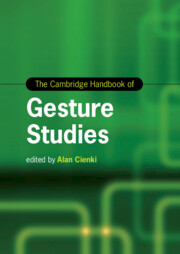Book contents
- The Cambridge Handbook of Gesture Studies
- Cambridge Handbooks in Language and Linguistics
- The Cambridge Handbook of Gesture Studies
- Copyright page
- Contents
- Figures
- Tables
- Contributors
- Introduction
- Part I Gestural Types: Forms and Functions
- Part II Ways of Approaching Gesture Analysis
- Part III Gestures and Language
- Part IV Gestures in Relation to Cognition
- Part V Gestures in Relation to Interaction
- 22 Gesturing for the Addressee
- 23 Gesture and Intersubjectivity
- 24 Variation in Gesture: A Sociocultural Linguistic Perspective
- 25 Communicative Gesturing in Interaction with Robots
- 26 Gestural Interfaces in Human–Computer Interaction
- Index
- References
26 - Gestural Interfaces in Human–Computer Interaction
from Part V - Gestures in Relation to Interaction
Published online by Cambridge University Press: 01 May 2024
- The Cambridge Handbook of Gesture Studies
- Cambridge Handbooks in Language and Linguistics
- The Cambridge Handbook of Gesture Studies
- Copyright page
- Contents
- Figures
- Tables
- Contributors
- Introduction
- Part I Gestural Types: Forms and Functions
- Part II Ways of Approaching Gesture Analysis
- Part III Gestures and Language
- Part IV Gestures in Relation to Cognition
- Part V Gestures in Relation to Interaction
- 22 Gesturing for the Addressee
- 23 Gesture and Intersubjectivity
- 24 Variation in Gesture: A Sociocultural Linguistic Perspective
- 25 Communicative Gesturing in Interaction with Robots
- 26 Gestural Interfaces in Human–Computer Interaction
- Index
- References
Summary
This chapter concerns the use of manual gestures in human–computer interaction (HCI) and user experience research (UX research). Our goal is to empower gesture researchers to conduct meaningful research in these fields. We therefore give special focus to the similarities and differences between HCI research, UX research, and gesture studies when it comes to theoretical framework, relevant research questions, empirical methods, and use cases, i.e. the contexts in which gesture control can be used. As part of this, we touch on the role of various gesture-detecting technologies in conducting this kind of research. The chapter ends with our suggestions for the opportunities gesture researchers have to extend this body of knowledge and add value to the implementation and instantiation of systems with gesture control.
Keywords
- Type
- Chapter
- Information
- The Cambridge Handbook of Gesture Studies , pp. 661 - 682Publisher: Cambridge University PressPrint publication year: 2024

